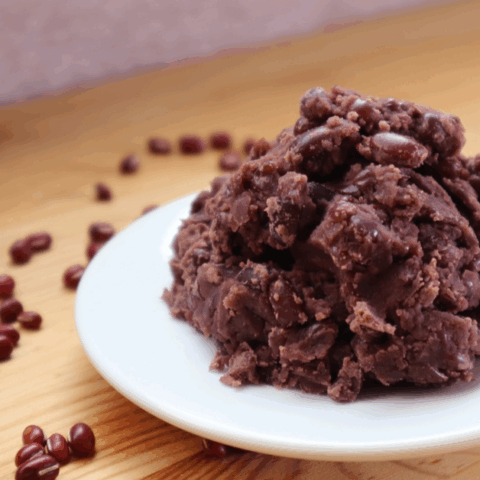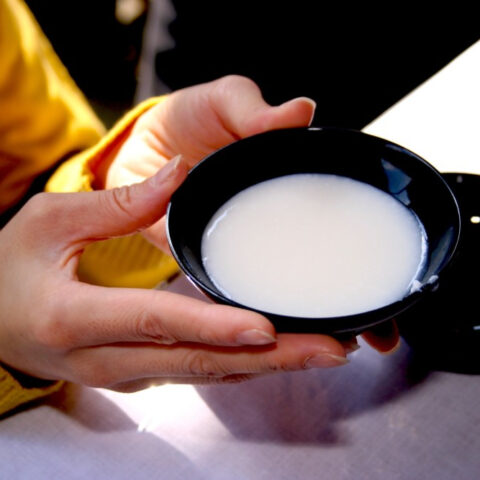
A culinary delight that has stood the test of time is the humble yet versatile red bean, otherwise known as anko. From classic favorites to modern twists, red bean treats have become an integral part of Japanese cuisine, each with its own story to tell. Let’s take a relaxed stroll through the various ways to enjoy these tasty treats, from the ever-popular Ogura Toast to the elegant Monaka, and appreciate the delicious history behind each one.

A slice of Ogura Toast with lots of butter – Photo by Lena Yamaguchi
Embrace Tradition With Ogura Toast
The beloved Ogura Toast said to have originated in 1921 at Nagoya’s Matsuba coffee shop, emerged from a delightful mishmash of sweet red bean soup and slices of toast dipped by curious patrons. Since then, it’s become a morning staple across Nagoya, with various coffee shops offering their unique spin on the classic. Crafting this iconic treat is surprisingly simple: thick slices of Japanese bread, toasted to perfection and slathered with butter, are generously topped with Ogura-an, also known as anko. There are endless variations, from adding whipped cream to sandwiching the bean paste between slices of bread.

Dorayaki: Japanese Sweet-Filled Pancakes – Photo by Julia Hartbeck
Journey Through Time with Dorayaki
Dorayaki, the iconic Japanese sweet featuring red bean paste nestled between two fluffy honey pancakes, carries with it a rich tapestry of tradition and folklore. Legend has it that its name, “Dorayaki,” originates from the word “Dora,” meaning gong, as tales tell of a resourceful farmer using a samurai’s forgotten gong to fry pancakes. Beyond its whimsical etymology, Dorayaki holds a special place in pop culture as the favored snack of the beloved character Doraemon. While the classic version boasts sweet red bean paste, adventurous variations offer fillings like custard or matcha, adding to the delight of this cherished treat.

MONAKA – Photo Courtesy of JAPAN CRAZE Magazine
Monaka: The Confectionery That Changes with the Times
Monaka, a beloved confection in Japan’s culinary heritage, has its roots in the mid-Edo period, originating from a snack called “Monaka no tsuki” sold in Yoshiwara. Initially, artisans crafted its delicate skin by blending glutinous rice flour with water, steaming it, and then baking it into thin rounds, reminiscent of sugared rice crackers. Interestingly, these early versions lacked the signature red bean paste filling that characterizes modern Monaka. It wasn’t until later that they were evolved to include red bean paste, becoming a staple treat. With advancements in mold technology during the Meiji Era, Monaka’s shapes expanded from traditional rounds to intricate patterns, reflecting its enduring popularity and adaptability. Modern-day Monaka enthusiasts are able to enjoy a variety of fillings such as chestnut, Gyūhi, rice cake, and even ice cream, offering a delightful fusion of tradition and innovation.

Manju – Photo by Julia Hartbeck
Celebrate Tradition with Manju
Manju is adored for its affordability and deliciousness, often enjoyed with tea or as a snack. These delightful treats feature a cake casing made of wheat flour, rice, or buckwheat filled with anko. Unlike mochi, Manju boasts a cake-like texture, offering a satisfying bite with each mouthful. Originating from 14th-century China’s Manju, this bun-like snack is said to have evolved to become predominantly vegetarian in Japan, reflecting Buddhist dietary customs. Today, Manju comes in various forms, with fillings ranging from traditional anko to white bean paste, chestnuts, fruits, and whimsical characters, embodying Japan’s culinary diversity and cultural heritage.

Anmitsu – Photo by Sakura from Zendine
Revive Tradition with Anmitsu
Anmitsu originated from the Tokyo store “Wakamatsu” in response to customers’ desire for sweeter treats. This delightful dish combines red bean paste with Mitsumame – a combination of agar jelly, boiled azuki beans, fruits such as apricot, mikan, and pineapple, rice cake, and sweet syrup – reflecting Japan’s evolving culinary landscape during the Meiji era. With its humble beginnings and rich history, Anmitsu continues to enchant dessert enthusiasts with its blend of textures and flavors. Whether enjoyed as a refreshing treat or a comforting indulgence, Anmitsu remains a beloved symbol of Japan’s culinary heritage, showcasing the perfect harmony of tradition and innovation.
As you can see, there is certainly a rich history within these simple red bean treats which offers a glimpse into Japan’s culinary heritage. Whether delighting in the comforting sweetness of Dorayaki or the refreshing bite of Anmitsu, each treat carries with it a piece of tradition and a moment of happiness. So, let’s take a moment to appreciate these timeless delights and the simple joys they bring, connecting us to Japan’s culinary legacy through every delectable bite.
Featured photo credit: Kenishirotie
If you want to learn more about Japanese sweets and cuisine, check out our Flavors of Japan walking tour in Tokyo to experience firsthand how Wagashi is made by a master.



